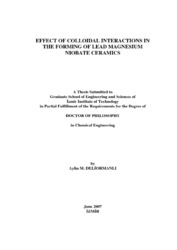Please use this identifier to cite or link to this item:
https://hdl.handle.net/11147/3633| Title: | Effect of Colloidal Interactions in the Forming of Lead Magnesium Niobate Ceramics | Authors: | Deliormanlı, Aylin Müyesser | Advisors: | Polat, Mehmet | Publisher: | Izmir Institute of Technology | Abstract: | Electrokinetic properties of lead magnesium niobate (PMN) powders in liquid medium are investigated in this thesis. Isoelectric point of aqueous PMN suspensions was determined as a function of solids concentration. Dissolution character of both Pb+2 and Mg+2 cations in PMN structure were examined as a function of pH. Poly(acrylic acid)-poly(ethylene) oxide PAA/PEO comb polymers were tested as the novel dispersant in this system and their effect on the stability and flow behavior of aqueous PMN suspensions was investigated. Stability and flow behavior were mainly studied by rheological measurements and sedimentation experiments as a function of pH and polyelectrolyte concentration. Adsorption of comb polymers onto PMN surface and their effect on the powder dissolution were also investigated. Results indicated that the PAA/PEO comb polymers impart stability to PMN suspensions over a wide pH range and ionic strength where pure PAA fails. In the course of this study PMN powders were consolidated using two different wet shaping methods. First, PMN films were produced using aqueous tape casting method which is widely used in the manufacture of multilayer ceramic capacitors. Secondly, three-dimensional PMN lattices were produced using robocasting method. In the former case, the goal was to provide alternative recipes for the aqueous tape casting process to be utilized in industrial applications since the current technology is based on the organic solvent based techniques. Results showed that it was possible to produce high quality PMN films with thicknesses in the range of 10 to 250 .m using aqueous based tape casting process. In the latter case, the results showed that robocasting is a suitable technique for the preparation of three dimensional PMN ceramics. Based on these results overall conclusion and the contribution of this study can be summarized as follows: The work carried out gives new insights into the manufacturing of PMN based ceramics using aqueous based techniques. Such improvements may bring benefits in the manufacturing of smaller electronic components employed in the personal computers and mobile phones and other consumer products in the near future. | Description: | Thesis (Doctoral)--Izmir Institute of Technology, Chemical Engineering, Izmir, 2007 Includes bibliographical references (leaves: 268-286) Text in English; Abstract: Turkish and English xxx, 299 leaves |
URI: | http://hdl.handle.net/11147/3633 |
| Appears in Collections: | Phd Degree / Doktora |
Files in This Item:
| File | Description | Size | Format | |
|---|---|---|---|---|
| T000621.pdf | DoctoralThesis | 107.04 MB | Adobe PDF |  View/Open |
CORE Recommender
Page view(s)
320
checked on Mar 3, 2025
Download(s)
96
checked on Mar 3, 2025
Google ScholarTM
Check
Items in GCRIS Repository are protected by copyright, with all rights reserved, unless otherwise indicated.